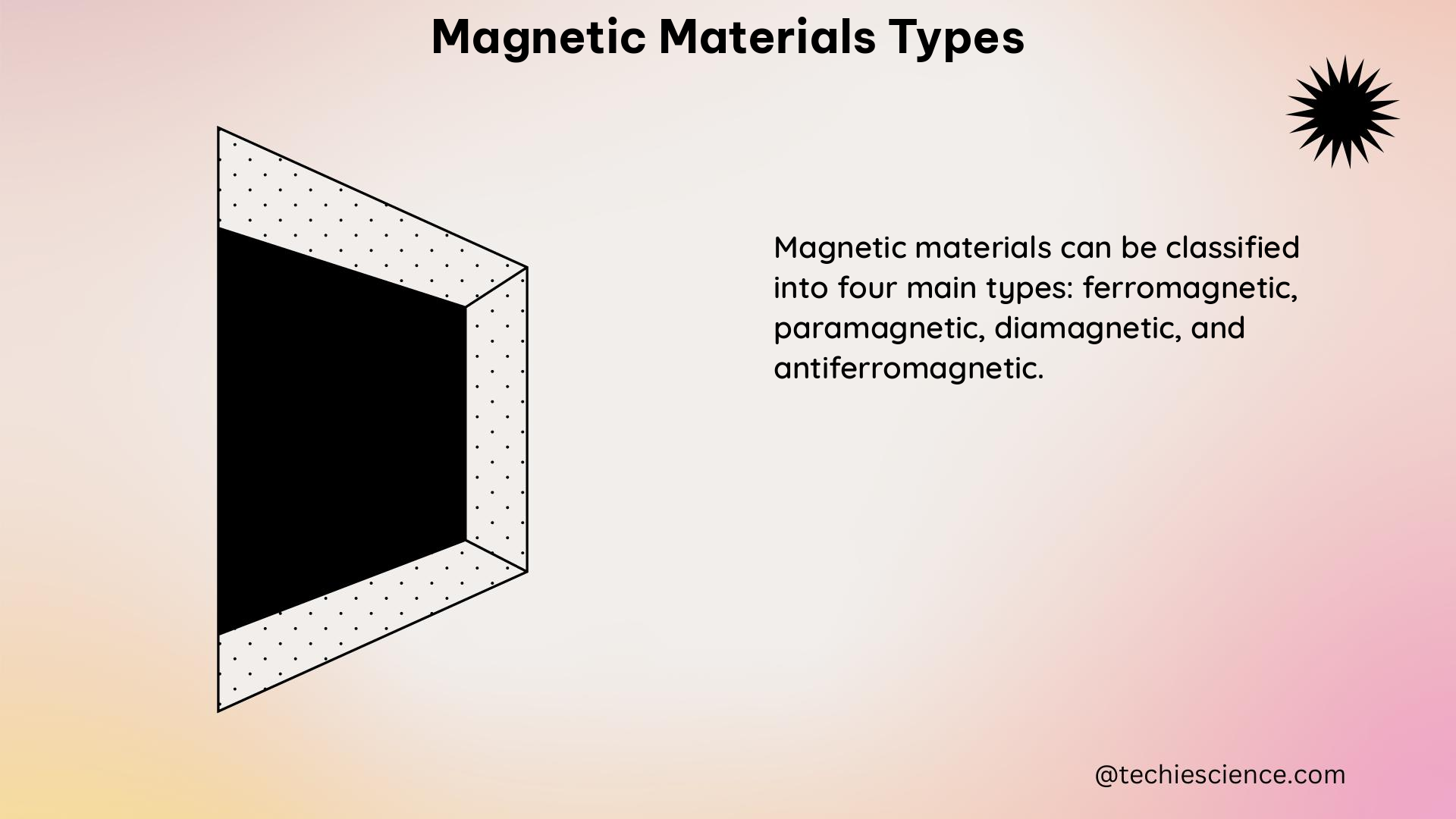Magnetic materials can be broadly classified into three categories: ferromagnetic, paramagnetic, and diamagnetic materials. Each type of magnetic material has unique properties and can be characterized by various measurable and quantifiable parameters. This comprehensive guide will delve into the intricate details of these magnetic materials, providing a thorough understanding for physics students.
Ferromagnetic Materials
Ferromagnetic materials are the most widely studied and utilized magnetic materials due to their strong magnetic properties and ability to be easily magnetized. These materials exhibit a spontaneous magnetization even in the absence of an external magnetic field, and their magnetic moments align in the same direction, resulting in a net magnetic moment.
Saturation Magnetization (Ms)
The saturation magnetization, denoted as Ms, is the maximum magnetization that a ferromagnetic material can achieve when it is fully magnetized. This parameter is a crucial characteristic of ferromagnetic materials and is measured in units of Tesla (T). The saturation magnetization is directly related to the magnetic moment of the atoms or ions within the material and can be calculated using the following formula:
Ms = Nμ / V
Where:
– N is the number of magnetic atoms or ions per unit volume
– μ is the magnetic moment of each atom or ion
– V is the volume of the material
The saturation magnetization of common ferromagnetic materials, such as iron (Fe), nickel (Ni), and cobalt (Co), can range from 1.6 T to 2.4 T, depending on the specific material composition and microstructure.
Remanence (Br)
Remanence, denoted as Br, is the magnetization that remains in a ferromagnetic material after the removal of an external magnetic field. This parameter is crucial for the design of permanent magnets and is measured in units of Tesla (T). The remanence of a ferromagnetic material is influenced by its microstructure, composition, and the strength of the applied magnetic field during magnetization.
The remanence of a ferromagnetic material can be calculated using the following formula:
Br = Ms (1 - e^(-t/τ))
Where:
– Ms is the saturation magnetization
– t is the time for which the external magnetic field is applied
– τ is the characteristic time constant of the material
The remanence of common ferromagnetic materials can range from 0.5 T to 1.4 T, depending on the specific material composition and processing conditions.
Coercivity (Hc)
Coercivity, denoted as Hc, is a measure of the resistance of a ferromagnetic material to becoming demagnetized. It is the magnetic field required to reduce the magnetization of the material to zero after it has been fully magnetized. Coercivity is measured in units of Oersted (Oe) or Ampere per meter (A/m).
The coercivity of a ferromagnetic material can be calculated using the following formula:
Hc = (6K1 / Ms) + (Nz Ms)
Where:
– K1 is the first-order anisotropy constant of the material
– Ms is the saturation magnetization
– Nz is the demagnetizing factor in the direction of magnetization
The coercivity of common ferromagnetic materials can range from 10 Oe to 2000 Oe, depending on the specific material composition and microstructure.
Curie Temperature (Tc)
The Curie temperature, denoted as Tc, is the temperature at which a ferromagnetic material transitions to a paramagnetic state. At this temperature, the material loses its spontaneous magnetization, and its magnetic moments become randomly oriented. The Curie temperature is a fundamental property of ferromagnetic materials and is measured in units of Kelvin (K).
The Curie temperature of common ferromagnetic materials can range from 600 K to 1400 K, depending on the specific material composition and structure.
Paramagnetic Materials

Paramagnetic materials exhibit weak magnetic properties and become magnetized only in the presence of an external magnetic field. Unlike ferromagnetic materials, paramagnetic materials do not possess a spontaneous magnetization, and their magnetic moments are randomly oriented in the absence of an external magnetic field.
Magnetic Susceptibility (χ)
The magnetic susceptibility, denoted as χ, is a measure of the degree of magnetization of a paramagnetic material in response to an external magnetic field. It is a dimensionless quantity that represents the ratio of the induced magnetization to the applied magnetic field. The magnetic susceptibility of paramagnetic materials is typically positive and small, ranging from 10^-5 to 10^-3.
The magnetic susceptibility of a paramagnetic material can be calculated using the following formula:
χ = C / (T - Tc)
Where:
– C is the Curie constant, a material-specific parameter
– T is the absolute temperature
– Tc is the Curie temperature of the material
The Curie constant, C, is a measure of the strength of the magnetic interactions within the paramagnetic material and is related to the magnetic moment of the atoms or ions. The Curie constant can be calculated using the following formula:
C = (Nμ^2) / (3kB)
Where:
– N is the number of magnetic atoms or ions per unit volume
– μ is the magnetic moment of each atom or ion
– kB is the Boltzmann constant
The magnetic susceptibility of paramagnetic materials is strongly dependent on temperature, and it decreases as the temperature increases, as described by the Curie-Weiss law.
Diamagnetic Materials
Diamagnetic materials exhibit no magnetic properties and become slightly magnetized in the presence of an external magnetic field. Unlike ferromagnetic and paramagnetic materials, diamagnetic materials do not possess any permanent magnetic moments, and their magnetic moments are induced by the applied magnetic field.
Magnetic Susceptibility (χ)
The magnetic susceptibility, denoted as χ, is a measure of the degree of magnetization of a diamagnetic material in response to an external magnetic field. It is a dimensionless quantity that represents the ratio of the induced magnetization to the applied magnetic field. The magnetic susceptibility of diamagnetic materials is typically negative and very small, ranging from -10^-6 to -10^-9.
The magnetic susceptibility of a diamagnetic material can be calculated using the following formula:
χ = -2μ0μB^2 / (3kBT)
Where:
– μ0 is the permeability of free space
– μB is the Bohr magneton, a fundamental unit of magnetic moment
– kB is the Boltzmann constant
– T is the absolute temperature
The negative value of the magnetic susceptibility indicates that diamagnetic materials are repelled by an external magnetic field, in contrast to ferromagnetic and paramagnetic materials, which are attracted to the field.
The magnetic susceptibility of diamagnetic materials is independent of temperature and the strength of the applied magnetic field, making them useful for various applications, such as magnetic shielding and the detection of small magnetic fields.
Hysteresis Loops
In addition to the parameters discussed above, the magnetic properties of magnetic materials can also be characterized by hysteresis loops, which describe the relationship between the magnetization and the magnetic field. The hysteresis loop is a graphical representation of the magnetization process, and it provides information about the energy required to magnetize the material.
The area inside the hysteresis loop is a measure of the energy required to magnetize the material, and it is known as the hysteresis loss. Ferromagnetic materials typically exhibit a larger hysteresis loop compared to paramagnetic and diamagnetic materials, indicating a higher energy requirement for magnetization.
The shape and size of the hysteresis loop are influenced by the material’s composition, microstructure, and processing conditions, making it a valuable tool for the characterization and optimization of magnetic materials.
Conclusion
In this comprehensive guide, we have explored the intricate details of the three main types of magnetic materials: ferromagnetic, paramagnetic, and diamagnetic. Each type of material exhibits unique magnetic properties that can be quantified and characterized using various parameters, such as saturation magnetization, remanence, coercivity, Curie temperature, and magnetic susceptibility.
By understanding the fundamental principles and characteristics of these magnetic materials, physics students can gain a deeper insight into the behavior and applications of these materials in various fields, including electronics, energy storage, and magnetic sensing.
References
- Jiles, D. C. (1998). Introduction to magnetism and magnetic materials. CRC Press.
- Spaldin, N. A. (2011). Magnetic materials: fundamentals and applications. Cambridge University Press.
- Tumanski, S. (2011). Handbook of magnetic materials. CRC Press.
